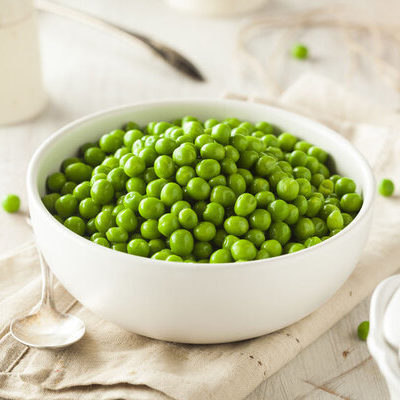
Peas
What are Peas?
Peas are the small, round, and green seed-pod of the Pisum sativum plant of the Fabaceae legume family. This food is commonly used as an ingredient in soups, salads, and stews.
- Peas are a popular vegetable as they are available all year round in fresh, frozen, and canned forms.
- The world’s largest producer and exporter of this vegetable is Canada.
The three main types of peas are:
- English or Garden
- Snow
- Sugar Snap
Origin of peas
Peas are believed to have originated in Southwestern Asia. Gradually, this vegetable spread to the temperate areas of Europe. The Greeks and the Romans were well acquainted with this food and even cultivated many new types of it. In the Middle Ages, farmers in the United Kingdom cultivated these legumes and they were extensively used in the cuisine of the time. The Austrian monk, Gregor Johan Mendel, experimented with peas in the 19th century, laying the foundation for modern genetics.
Function
Peas are a significant plant crop, because they can be consumed in many ways. Several parts of this plant play a role in people’s diets. In parts of Africa and Asia, the green foliage of this plant is used as a vegetable. The ripe dried seeds from the pod can also be ground into flour. Additionally, the seeds are commonly eaten in baked, boiled, and roasted dishes.
Nutrition
A serving size of 100g of raw green peas offers:
- 81 calories
- The total fat of 0.4g
- 5.4g of protein
- 14g of carbohydrates
This food has several health benefits, which include:
- It is rich in antioxidants, which help to fight inflammation.
- This food contains chemical compounds that help to slow down aging.
- It can help to stabilize the blood sugar level.
- This food can help boost your immune system.
- It can supply essential nutrients for healthy bones.
Commercial production
These legumes grow best in well-drained soil with a pH range of 6 to 7.5. They also grow well in sandy and clay-like soils. However, these plants don’t thrive under waterlogged soil conditions. The best temperature for this plant is between 55.4°F to 64.4°F. People cultivate this food at high altitudes and even in tropical areas. Other processes like fertilizer application and weed control are essential in the growth of this vegetable.
These pods’ global production is expected to grow at a rate of 5.9% between 2019 and 2024. Additionally, in 2017, the value of the global pea protein market reached $32.09 million. This value has been estimated to hit $176.03 million by 2025.
Application
Green peas are easy to preserve at home, for up to a year, using the following steps:
- First, shell the pods and place them in a container. Throw out any that have gone bad.
- Next, wash the seeds under clean running water.
- Then, add water to a pot and boil it.
- After that, pour two teaspoons of sugar into the boiling water.
- Then, add the seeds into the water and stir for two minutes.
- Move the seeds from the boiling water to cold water. Keep them there for about two more minutes.
- Next, drain any remaining water.
- Finally, pour the pods into a ziplock bag and place them in the freezer.
When you want to buy these legumes in the market, look for light green pods that contain small seeds that are still intact. Don’t purchase spoilt or soft pods.
Pea recipes
Peas can be used to add flavor and nutrients to many dishes. Here are some popular recipes:
- Slow-Cooker Pea and Ham Soup
- Pea and New Potato Curry
- Herby Pea and Lemon Pasta Salad
- Traditional British Mushy Peas
- Chicken Pot Pie
FDA regulation
The Food and Drug Administration classifies this food as a raw agricultural commodity. The body also regulates its processing, production, and harvesting. Furthermore, the FDA has a standard of identity for canned peas. They define it as the food prepared from fresh or frozen succulent seeds of this crop plant’s specified species. The body oversees the production, processing, packaging, and labeling of this canned food, as well.
References
“Peas.” Alliance Seed, Alliance Seed, 28 Oct. 2019, www.allianceseed.com/varieties/peas/.
“CFR – Code of Federal Regulations, Title 21.” accessdata.fda.gov, U.S Food & Drug Administration, 1 Apr. 2019, https://www.accessdata.fda.gov/scripts/cdrh/cfdocs/cfcfr/CFRSearch.cfm?fr=112.1&SearchTerm=pea
Roy’s Farm. “Growing Peas Commercially (Matar Farming).” www.roysfarm.com, Roy’s Farm blog, 29 Oct. 2018, https://www.roysfarm.com/growing-peas-commercially/
